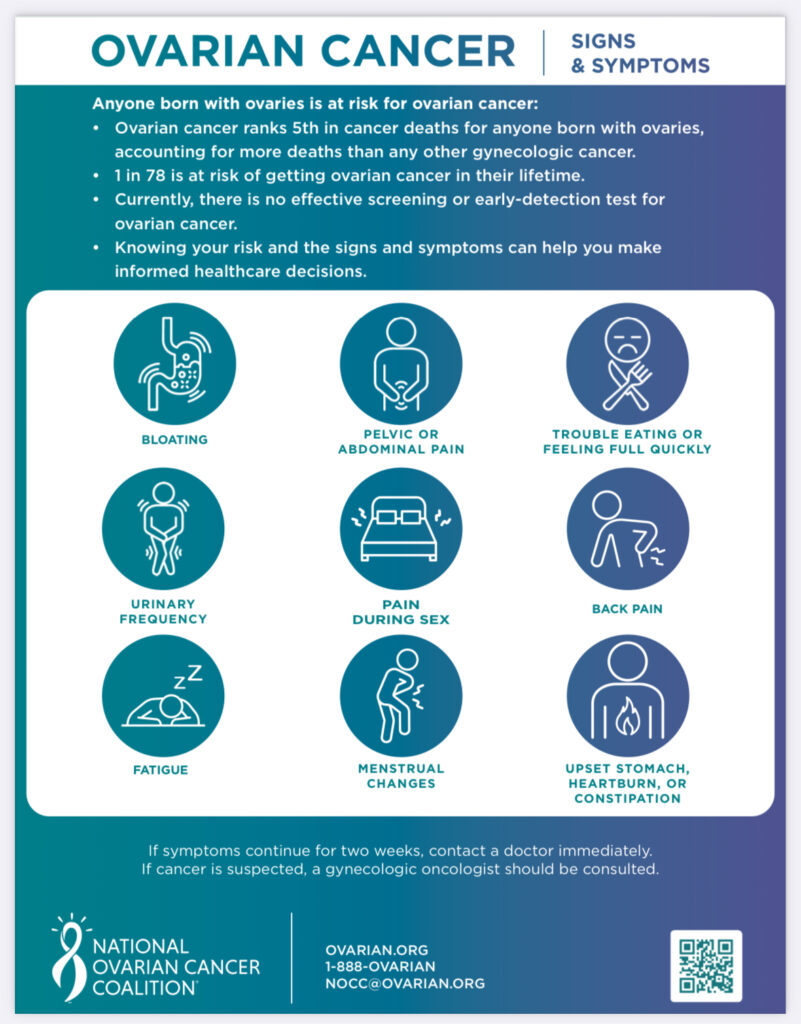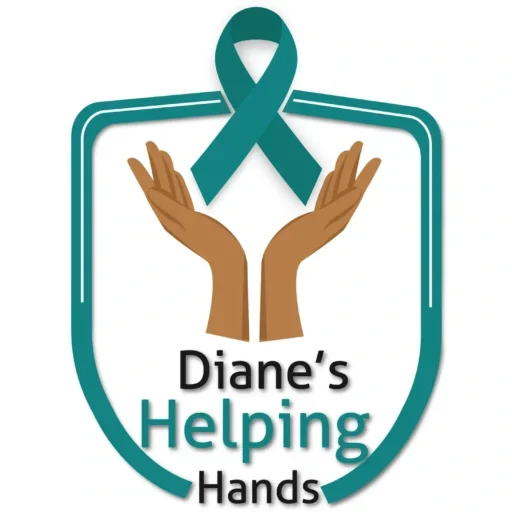Learn More About Ovarian Cancer
Ovarian Cancer: The Facts
Ranked fifth in cancer deaths among women, ovarian cancer accounts for more deaths than any other cancer of the female reproductive system. A woman's risk of getting ovarian cancer during her lifetime is about 1 in 78. Her chance of dying from ovarian cancer is about 1 in 108 (not including low malignant potential ovarian tumors.) More common in older women, approximately 50% of the women diagnosed with ovarian cancer are 63 years or older. Early detection of ovarian cancer is crucial.
Ovarian Cancer: Signs & Symptoms

F.A.Q.
Ovarian cancer is a type of cancer that starts in the ovaries or related areas of the fallopian tubes and the peritoneum. There are different types of ovarian cancer and different types of tumors. The most common tumor type is high-grade serous carcinoma, which occurs in about 70% of ovarian cancer cases.
Early-stage ovarian cancer often has no obvious symptoms but early detection can improve your options for treatment. Listen to your body and remember the B.E.A.T. of ovarian cancer symptoms:
Bloating that doesn’t come and go
Eating less or feeling full more quickly
Abdominal and pelvic pain that doesn’t go away
Toilet changes including urinary or bowel urgency or frequency
Other symptoms can include vaginal bleeding (particularly if you are past menopause), discharge from your vagina that is not normal for you, pain or pressure in the pelvic area, and abdominal or back pain.
If you experience any of these symptoms persistently, it's important to see your doctor as soon as possible.
Some key risk factors for ovarian cancer include:
- Older age (most cases occur in women over 50)
- Family history of ovarian, breast, or colon cancer
- Certain genetic mutations like BRCA1 and BRCA2
- Never having children or having children later in life
- Hormone replacement therapy after menopause
- Obesity
Being aware of your risk factors can help you and your doctor monitor your health and increase the chances of early detection.
Ovarian cancer is the 5th leading cause of cancer death in women in the United States. Each year, about 21,000 women are diagnosed with ovarian cancer.
Ovarian cancer originates in the ovaries, while other gynecological cancers start in different female reproductive organs:
- Uterine/endometrial cancer begins in the uterus
- Cervical cancer starts in the cervix
- Vaginal cancer develops in the vagina
- Vulvar cancer forms in the vulva
Each type of gynecological cancer has distinct symptoms, risk factors, and treatment approaches.
If your doctor suspects ovarian cancer, they may recommend some of the following diagnostic tests:
- Pelvic exam
- Imaging tests like ultrasound, CT scan, or MRI
- Blood test to measure CA-125 levels (a protein that can be elevated in ovarian cancer)
- Biopsy
Treatment for ovarian cancer depends on the stage and type of cancer, as well as your overall health. Common treatments include:
- Surgery to remove the tumor and affected ovaries, fallopian tubes, or other organs
- Chemotherapy
- Targeted therapy medications
- Radiation therapy in some cases
Every patient is different and you should speak to your doctor about the best treatment plan.
Ovarian cancer incidence rates are lower in African American women compared to white women. The data shows that about 1.3% of women will be diagnosed with ovarian cancer at some point in their lives, but the incidence rate is less than 1% for African American women.
While African American women have a lower incidence of ovarian cancer, they are more likely to die of the disease than white women. The lower survival rates in the African American population apply no matter what age the patient is when they are diagnosed. The reasons for this survival gap are complex, but may be due to differences in access to good medical care, health insurance disparities, support networks, and biological factors.
Receiving an ovarian cancer diagnosis and going through treatment can be an incredibly challenging experience, both physically and emotionally.
- Communicate openly with your healthcare team: Ask questions, express concerns, and work collaboratively on your treatment plan.
- Prioritize self-care: Get plenty of rest, eat a nutritious diet, stay hydrated, and light exercise. Ask loved ones for help with household tasks to focus on your health.
- Build a strong support network: Lean on family, friends, and ovarian cancer support groups for emotional and practical support.
- Manage stress and emotions: Practice stress-relieving activities like meditation, deep breathing, or journaling. Consider seeking professional counseling or therapy if needed.
- Advocate for yourself: Educate yourself about your diagnosis and treatment options. Speak up if you have concerns or need additional support
Remember, you are not alone. Your healthcare team and various resources are here to guide and support you throughout your ovarian cancer treatment journey.
If your friend or family member is undergoing treatment for ovarian cancer:
- Educate yourself about ovarian cancer and the treatment process so you can better understand and anticipate your loved one's needs.
- Communicate openly with the healthcare team and advocate for your loved one's care. Attend appointments and take notes.
- Offer practical help with tasks like transportation, meals, household chores, and managing paperwork and finances.
- Provide emotional support by listening, validating feelings, and creating a safe space for your loved one to express themselves.
- Take care of your physical and mental health through self-care activities, support groups, and respite care when needed.
- Establish boundaries and learn to say "no" to avoid caregiver burnout.
There are many online and local resources and support groups that you can lean on at this time. Two useful resources of general information online are the Center for Disease Control and Prevention and the National Ovarian Cancer Coalition. Always speak to your doctor about questions specific to your medical care. Your healthcare team is also a good resource for information about support groups in your area.

